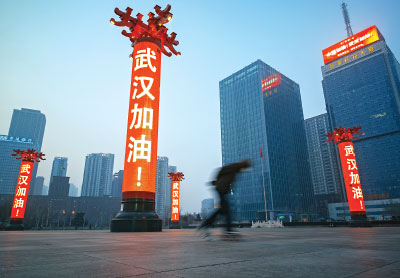Psychiatrist Shares Her COVID-19 Experience and Advice
Abstract
A psychiatrist shares her story of providing mental health support to health care professionals responding to the COVID-19 crisis in Wuhan, China, and becoming a patient herself.

When I first planned a trip many months ago to visit family and friends for the Chinese New Year in Beijing, I had not anticipated that Wuhan would be locked down the next day. The bustling streets around this time of the year were unusually tranquil and quiet. The vibrant Beijing skylines were seemingly dimmed as a show of respect for the sacrifices that citizens and Wuhan’s health care workers were making for the well-being of their nation.
As a psychiatrist, I joined a group of U.S. mental health professionals—TopGun Peer Support Wuhan—soon after the lockdown to provide much-needed online psychological support for Wuhan’s front line of medical professionals combating COVID-19. These physicians and nurses had worked around the clock managing severe medical conditions while facing life and death situations daily for over two months. In doing so, they experienced mental and physical exhaustion as they treated an overwhelming volume of patients. Moreover, these professionals expressed fear, frustration, and sadness as many of them saw colleagues fall ill to or even die from the virus that they were so desperately fighting against; however, they continued to provide care for their patients despite these dire circumstances.
During this process, I gained invaluable insight on the treacherous nature of this new type of coronavirus infection: The different subtypes of the virus; the variability of clinical presentations; the tortuous course of the disease; and horrible outcomes of some patients, if not treated early enough, who succumbed to pneumonia through the precipitation of an “inflammatory storm.” Without much contemplation, I decided to end my trip early and return to my home in New York just before the United States began banning flights from China. During my 14-day self-quarantine at home, I started seeing news of COVID-19 sneaking through the borders of Singapore, South Korea, and Japan and then sweeping across continents to Italy, Germany, and other European countries. It was only a matter of time before it came to the United States.
The outbreak of COVID-19 began insidiously in the next six weeks. This was before people truly understood the severity of the disease. It was much more serious than the “common cold” to which it had been compared. It was more contagious and deadlier than the flu. People had to press pause on their normal lives and begin social distancing. Suddenly, millions of people became unemployed, and anger, fear, and anxiety arouse quickly in people who depended on hourly work and daily paychecks to feed their families. Others became anguished when faced with the complete disruption of their lives. Hospital employees’ and management’s attitude toward wearing masks and personal protective equipment changed dramatically. Hospital systems became overwhelmed with COVID-19 patients occupying almost all the ICU beds available. The learning curve to deal with COVID-19 was steep for everyone.
I have always been healthy and physically active, but when I finally began experiencing fever, chills, body aches, loss of taste and smell, nausea, and dry cough for two consecutive days, I knew I was infected with COVID-19, which a test later confirmed. I developed viral pneumonia when the outbreak reached our borough in New York in the middle of March. After two months of witnessing the devastating course of this disease on patients and the health care system and with fewer than 300 officially reported positive cases in New York at the time, I knew we had to face it with full strength. However, during the initial course of my illness, I felt somewhat dissociated in my mind and body. I felt sadness, disappointment, and disbelief. I had difficulty breathing, chest pain, and low oximeter readings. During this time, scenes of people shedding tears and working in a concerted effort across the world to get through this crisis ran through my mind.
As I laid in bed and watched the case numbers skyrocket day by day in New York and across the country, I found myself unable to differentiate whether the fear came from my own shortness of breath or its psychological effects—despite my efforts to exercise mindfulness. Early on, I was prescribed supportive treatment and antiviral medications that were shown to be effective in quasi-clinical trial data contributed by clinicians from other countries; most U.S. physicians are skeptical of the data’s validity. Thankfully, I responded well to the treatments, and a couple of weeks later as I write this article, I am almost fully recovered.
Throughout my experience of this global pandemic, I am reminded of the interconnectedness of the world. The voices of leaders, scientists, clinicians, and the general public of various nations should be heard and listened to, and valuable information should be exchanged to add to the ever-evolving data we are tracking, from whatever country or health system, so that we can fight in a concerted fashion and ease the physical and mental anguish caused by this disease. Our governments and our leaders must take on the responsibility of serving their people, responding to citizens’ desires and needs, and act selflessly. They need to broadly and aggressively strengthen our efforts to defeat COVID-19 and gradually bring the world into a hoped-for stage of healing. ■



